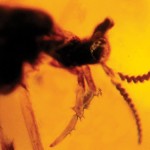
These new arrivals are thriving. Image: Lisa Cavanagh.
Five lizard hatchlings have joined the reptile family at Tarong zoo.
In late April, the keepers at Taronga Zoo watched the five rhinoceros iguanas hatch. These lizards get their name from the growths on their snouts and can grow to over a metre in length.
Rhinoceros iguanas are native to the island of Hispaniola in the Caribbean, which is shared by the Dominican Republic and Haiti. They are classified as threatened, as they are hunted by feral animals such as cats and mongoose. They are also affected by deforestation and other human activities.
After hatching over 100 of these little iguanas, the keepers knew just what to do when the eggs were laid in late January. Two of the most important factors for hatching reptile eggs are constant temperature, around 30Ëš C and a good incubating medium.
In the wild, many lizards, including the iguanas, will seek out the ideal nesting site and bury their eggs. They still do this in zoos, but to give the eggs the best chance of hatching, the keepers remove them to a more controlled environment to reduce temperature fluctuations.
The eggs were nestled in a mixture of water and vermiculite so they are just covered, making sure not to turn them. If they are fertile, the warmth and humidity allow the rhinoceros iguana eggs to hatch in approximately 110 days unassisted.
Now that they’ve hatched, the babies are on the same diet as their parents. It’s called iguana mix and contains a combination of chopped fruit and vegetables, with a sprinkling of calcium and multivitamin powder. They also eat foliage such as hibiscus flowers, mulberry leaves and other vegetation, ensuring a mixed diet.
When the hatchlings have grown, some will be placed on display at Taronga, while others will go to live in other zoos around Australia.






